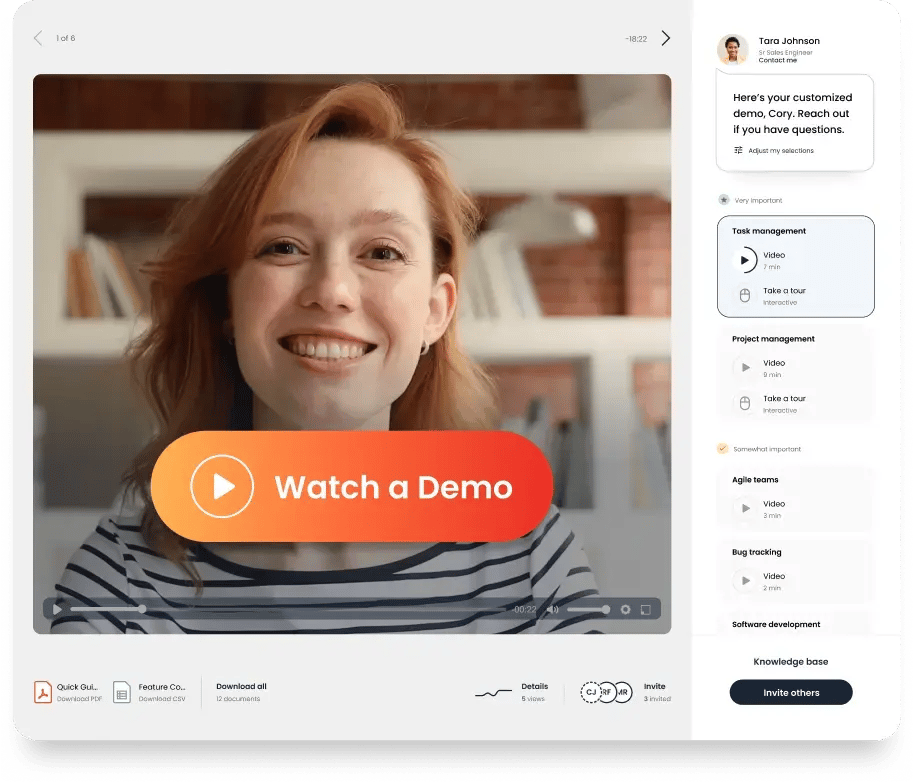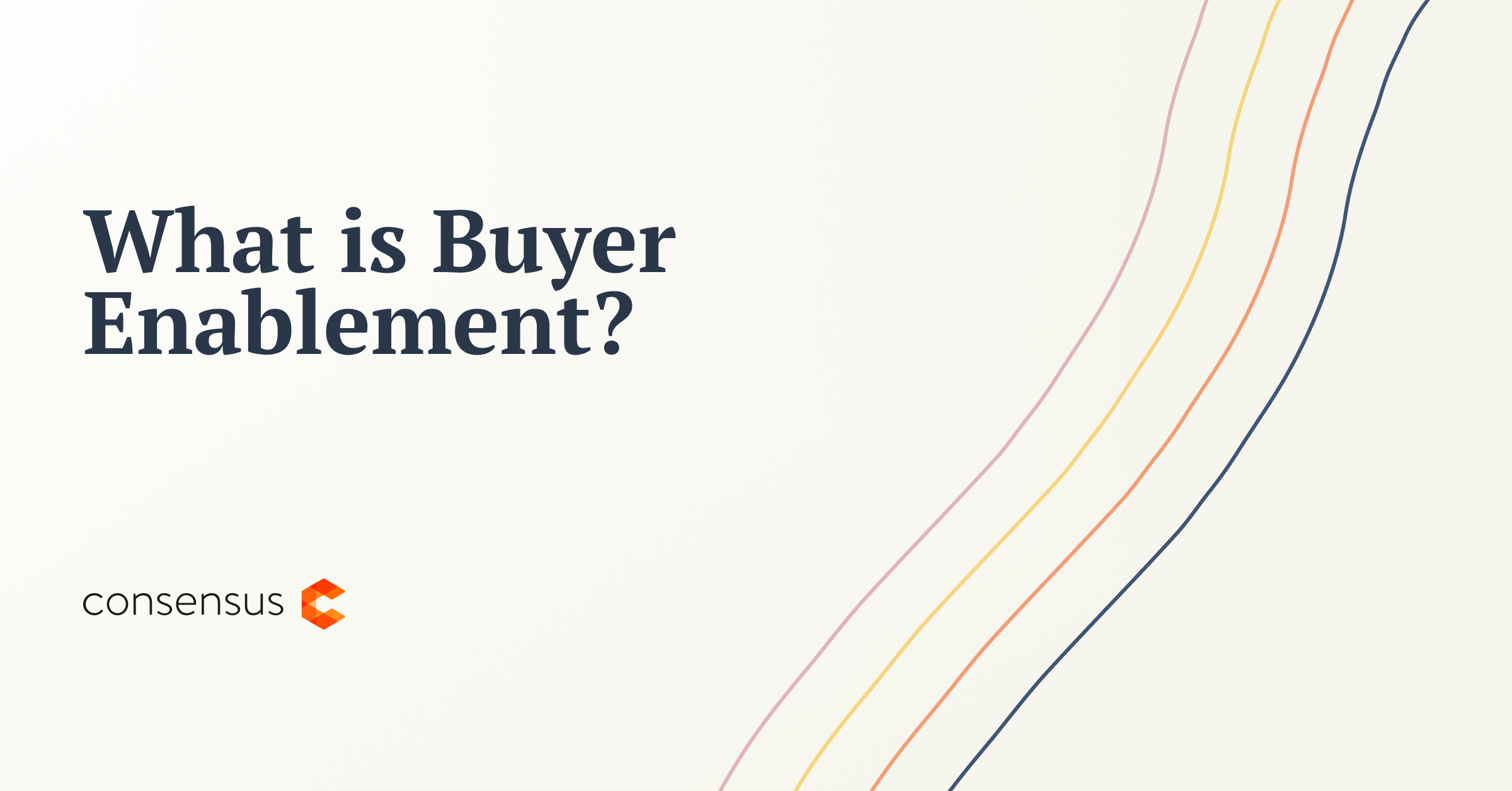Experienced marketing professional who focuses on revenue, enables sales teams, effectively ...
Close more deals with
Demo Automation.
Watch a Demo
Your sales demo script is the backbone of your presentation. What you say to customers could turn a qualified lead into a sale—or result in an unexpected loss. A well-structured and thoughtful script helps buyers visualize how your solution works in their unique context and feel confident moving forward.
Now that buying committees typically involve six to 10 stakeholders, sales teams are adapting by using strategies like demo automation to deliver tailored, on-demand experiences at scale. Paired with a sharp, intentional sales demo script, the approach creates a seamless path from interest to decision.
This guide breaks down how to craft a sales demo script that draws buyers in, highlights common pitfalls to avoid, and provides a free sales demo script you can use as a jumping-off point.
What is a Sales Demo Script?
A sales demo script is the written speech you give when presenting a sales demo to potential customers. The script tells the story of your presentation’s visuals, providing built-in guideposts to make sure your demos hit the mark every time.
A well-prepared sales demo script highlights the features that matter most to buyers and connects those features directly to their business challenges. It’s an essential part of delivering impactful demos that help buyers see the value of your product faster—and boost the odds of them becoming a customer sooner.
With 75% of B2B buyers preferring a rep-free sales experience, your script is a critical tool for standing out when you manage to get in front of a buying committee.
How to Structure Your Sales Demo Script
A well-planned sales demo script helps potential customers see the value of your solution in clear, relatable terms. Here’s how to create a sales demo script that’s focused, engaging, and tailored to the specific challenges your buyers face.
Start with the Main Message
Kick off your demo with a strong value proposition that immediately addresses your buyer’s overall pain points. Then, hook them by highlighting exactly how your solution can make a difference in their business.
For example, “Many companies in your industry struggle with [pain point 1], [pain point 2], and pain point 3], causing teams to lose a minimum of [number] hours per week to [unnecessary tasks]. Over the next [number] minutes, I’ll show you how [product] can streamline your workflow, so your team can get back to [specific company goals].”
Ask About the Customer’s Needs
Setting the stage for an interactive and impactful demo involves asking questions. Find out your audience’s unique challenges and needs so you can tailor your demo on the fly to be hyper-relevant to their situation. This shows them you’re genuinely interested in their success.
Before diving into your presentation, you might ask questions like:
- Which [industry-wide challenges] are you struggling with most?
- What are the setbacks you’re experiencing as a result of [pain point]?
- How much time is your team losing to [pain point your product solves] per week?
- What’s driving you to consider a solution like [product] for your company?
Provide a Product Overview Tailored to the Customer
Offer a personalized product overview that speaks directly to the pain points your audience just shared with you. Reference their own words back to them wherever possible as you highlight your product’s features and the problems they solve for their industry, role, and unique challenges.
Using a product experience platform like Consensus, you can deliver engaging overviews to your buyers—and without adding to your revenue teams’ workload. On-demand video demos allow buyers to define what features they care about most, so they can watch a product overview that addresses their exact use cases and pain points. This makes it easy for them to envision what it would be like to use your platform to solve their challenges.

Demonstrate the Value
Showcase the tangible benefits of your product by demonstrating exactly how it can deliver results for them. Use real-world examples, share stories, and provide case studies that mirror your buyer’s situation and future goals. Illustrate its value in a way that deeply resonates so they have no choice but to sign up.
Prepare for Objections
Anticipate common objections and address them head-on during your demo. Show empathy for your buyer’s concerns and provide clear, well-supported answers for them to consider.
- For missing feature concerns: “Have you heard of [partner service]? Its [desired feature] integrates seamlessly with [product], with many of our customers reporting a [percentage] reduction in [pain point] within [timeframe].”
- For implementation concerns: “I completely understand how overwhelming making updates can be. Fortunately, [product] integrates into your already established processes—our average customer is up and running same-day, and our onboarding process only takes 20 minutes.”
- For budget concerns: “We keep budget concerns top of mind, which is why we offer flexible payment plans so you’re only paying for the features you need and nothing more. Most companies see ROI within the first 30 days of using [product]. For example, automating [specific process] [saves/makes] [similar company] an average of [hours/dollars] per month.”
Taking a proactive approach mitigates doubts and keeps the conversation moving forward.
Use a CTA to Reinforce Your Value Prop
Wrap up your sales demo with a compelling call to action that underscores your value proposition, aligns with your buyer’s goals, and encourages them to take the next step—whether that’s booking a follow-up call, starting a free trial, or signing a contract.
Make it easy for them to act and make sure they leave your demo with a clear path forward
Sales Script Example
Now that you know the components of a next-level sales demo script, here’s a sample script you can use as a jumping off point to draft your own. Make sure it’s as personalized as possible by speaking directly to your buyer’s specific pain points and goals—both short-term and long-term. Show them you understand their industry and care about elevating their place in it.
“Hi everyone—it’s nice to meet you all. My name is [your name], and I’m with [company name]. Over the next [specific timeframe], I’m going to show you how [your product] can help [buyer’s company] solve [specific pain points] and [reach specific goals].”
“Before I get started, I’d like to understand a bit more about your specific challenges with [pain points] and how you’re currently navigating them. What are the most urgent problems you’d like to tackle?”
“At [company name], we specialize in [brief explanation of what your product does]. Unlike other solutions, our product [highlight unique features and advantages that cater directly to your buyer’s pain points]. This means you can [specific benefits or outcomes that align with your buyer’s goals].
Now, let’s get into how [your product] can directly address these issues, starting with [most urgent pain point]. Earlier, you mentioned problems with [specific challenge]. Here’s how you can solve [problem] using our product… Instead of [current way of doing things], [your product] will [describe the end result and how it helps your buyer solve their problem]. All you have to do is [show how they would use your product to make it happen].”
[Repeat this process with each of the most urgent problems your buyer mentioned.]
“Many of our customers have experienced similar challenges and found that our [specific product features] were instrumental in [solving specific problems]. For example, one of our customers experienced an increase in [improvement that aligns with buyer’s goals]. This helped them [achieve goal, e.g. reduce costs] by [specific percentage].”
“I noticed you’re using [current system] for [current outcome] and it’s causing [specific pain point]. Our product’s [irresistible feature] solves this problem by [showcase the feature in action as you explain how it can help your buyer’s business achieve big things].”
“Some of you are probably concerned about [mention common objections, like initial cost or integration with existing systems], which is understandable. Let me address them for you now… [highlight each concern and how the value your product provides outweighs each of them].”
“As you can see, [your product] offers a game-changing solution for [buyer’s company] to [reach future goals] by [solving specific pain points]. And this is only the beginning. Would you like to book a follow-up call to explore next steps?”
What to Avoid in Your Sales Demo Script
While it’s helpful to know what to cover in a sales demo–it’s just as important to know what to avoid. Steer clear of potential misunderstandings and lost opportunities by removing these phrases:
1. ‘Our competitor doesn’t do this.’
Products are constantly evolving and updating, especially in the world of SaaS sales. It’s risky to claim a competitor with a similar product doesn’t have certain functionalities, as this may not remain true over time.
Calling out competitors also makes it seem like your product doesn’t speak for itself. Buyers want to learn about your product more than they want to be sold to. Your customers will naturally gravitate toward the product that best addresses their pain points, and ask competitors themselves if they have the same benefits as your brand.
What to say instead: “Customers who compared our product to others in the space found this to be a differentiating feature.”
This phrasing offers a subtle nod to your competitors without calling them out directly. It also uses your previous customers as social proof, rather than insisting your buyer take your word for it. Your buyer can then verify this information while shopping around.
2. ‘Do we have a hard stop?’
The moment a buyer hears you ask if you have to end at a certain time, they’ll likely assume your presentation is going to be longer than expected. This may cause them to lose focus during your demo and think of the time they’re losing or their unfinished tasks instead.
Some customers may even start multi-tasking, splitting their attention between your product demo and other responsibilities.
What to say instead: “We’re scheduled to end at [time]. Is there anyone who needs to leave early?”This alternative reassures your customers that you plan on sticking to the intended schedule, but are considerate of their unique schedules. It also allows you to adapt your demo to fit within new time limits or address the needs of high-value stakeholders if they need to leave early. You may also consider sending an automated demo as a follow-up so stakeholders can review anything they might have missed.
3. ‘Our product is easy to use.’
Easy is subjective. What you consider easy isn’t necessarily the same as your customer, especially when you take into account your level of experience with products in this space. Your customer may have little to no experience using products in your category, which means yours could be just as difficult for them to familiarize themselves with as your competitors’.
What to say instead: “This is how you use our product, and we offer support if you have any questions.”
Showing—rather than telling—your customers how easy your product is to use allows them to come to the conclusion themselves or ask clarifying questions. If you use enablement tools like interactive product tours, you can even let your customers experience a taste of your product themselves.
When demonstrating your product, be clear in your explanation. Consider how you would use your product if you didn’t know anything about it. Highlighting your support team also reassures your customers that there will be help available to guide them through issues so they won’t be forced to figure it out themselves.
4. ‘Let’s talk soon.’
Scheduling follow-ups is an essential part of the sales process. However, this vague phrasing leaves the burden of scheduling another meeting up in the air for both you and your customer. Failing to give your customer clear next steps can slow or even stall a deal by leaving them unsure about what to expect after this interaction.
What to say instead: “I understand you’re likely very busy, so would [time and date] work for us to reconnect and discuss this further?”
Offering your customer a set time and date, or multiple options, for your next interaction removes the responsibility from their plate, reducing the friction of meeting again. Setting up a concrete time demonstrates follow-through on your end and can also help you determine if a client is actually interested, depending on how receptive they are to setting up another call.
Sales Demo Best Practices
Keep the following best practices in mind to make your sales demos as compelling and memorable as they are informative.
1. Start with 24/7 Available Automated Demos
In an ideal world, every sales demo would be live and precisely tailored to the individual buyer’s challenges. But a packed schedule of real-time demos is resource-intensive, not to mention impossible to scale. They’re also not what buyers want.
70% of buyers prefer to self-serve. They don’t want to wait days for a demo slot or sit through features they’ll never use to solve pain points they don’t have. Make it easy for potential customers to buy from you by offering automated sales demos that are accessible around the clock. Buyers can explore your product whenever suits them best, positioning your solution as a proactive partner in their buying journey.
When you use Consensus’ Product Experience Platform, you can customize your buyer’s journey at every stage and move your high-interest buyers through your sales funnel more efficiently. You’re also able to integrate lead forms and CTAs right into your demos, capturing leads at rates four times higher than standard landing pages.
Automated demos help identify product qualified leads (PQLs) by allowing buyers to engage with your product without delay. With Consensus’ on-demand demos, your buyers can qualify themselves for live calls, wiping unqualified and unnecessary demos from your team’s calendar. This gives your presales team 30% or more time back in their week to put toward higher-stakes tasks.
Using Demolytics, you can better understand who your buyers are, what matters to them, and how your sales team can align on next steps—all while buyers get the self-serve experience they prefer.
The result? Faster close times, larger deals, and higher close rates.

Watch a demo to check out Consensus in action.
2. Link the Product Features with Buyer Pain Points
When you’re walking buyers through how your product works, it’s crucial to connect your features to the specific challenges they face. Start by identifying their key pain points, then showcase how your product specifically addresses those issues. This transforms a standard demo into one that builds trust and positions you as a reliable partner in their success journey.
For example, if a buyer’s wasting too much time and resources on demos to unqualified prospects and your product has helped customers achieve an 89% reduction in unqualified demos, then you could share that company’s case study as part of your sales demo script.
3. Encourage Interaction
Think of your demo as a conversation, not a monologue. Invite questions and encourage feedback throughout your presentation. Interacting with your audience keeps them engaged and makes them feel heard, while also building confidence in your product and its capabilities.
Automated demos aren’t generic or impersonal when you create them with Consensus. Instead, buyers get personalized video demos throughout their buying journey. Thanks to features like branching questions and feature selections, buyers get a tailored, interactive product experience that perfectly addresses their pain points as they get to know your product.
Improve Your Sales Demo Process for Higher Conversions
Great sales demos are pivotal to closing deals, especially in complex B2B environments. Buyers today want demos that are tailored to their specific needs. That means moving beyond the one-size-fits-all sales demo script and delivering narratives that clearly show how your product solves particular challenges.
Buyers also want convenience. And with Consensus, you can deliver personalized demos on demand that buyers can engage with on their own terms, while gathering deep insights into what matters most to them—and use that data to close deals 30% faster.
To see how Consensus can take your sales demos to the next level, experience the benefits of demo automation firsthand. Accelerate your sales team’s impact by making buying easy.





